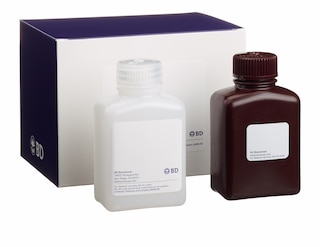-
抗体試薬
- フローサイトメトリー用試薬
-
ウェスタンブロッティング抗体試薬
- イムノアッセイ試薬
-
シングルセル試薬
- BD® AbSeq Assay | シングルセル試薬
- BD Rhapsody™ Accessory Kits | シングルセル試薬
- BD® Single-Cell Multiplexing Kit | シングルセル試薬
- BD Rhapsody™ Targeted mRNA Kits | シングルセル試薬
- BD Rhapsody™ Whole Transcriptome Analysis (WTA) Amplification Kit | シングルセル試薬
- BD Rhapsody™ TCR/BCR Profiling Assays (VDJ Assays) | シングルセル試薬
- BD® OMICS-Guard Sample Preservation Buffer
-
細胞機能評価のための試薬
-
顕微鏡・イメージング用試薬
-
細胞調製・分離試薬
-
- BD® AbSeq Assay | シングルセル試薬
- BD Rhapsody™ Accessory Kits | シングルセル試薬
- BD® Single-Cell Multiplexing Kit | シングルセル試薬
- BD Rhapsody™ Targeted mRNA Kits | シングルセル試薬
- BD Rhapsody™ Whole Transcriptome Analysis (WTA) Amplification Kit | シングルセル試薬
- BD Rhapsody™ TCR/BCR Profiling Assays (VDJ Assays) | シングルセル試薬
- BD® OMICS-Guard Sample Preservation Buffer
- Japan (Japanese)
-
Change country/language
Old Browser
Looks like you're visiting us from {countryName}.
Would you like to stay on the current country site or be switched to your country?


.png)

Detection of intracellular rat IgG1 in an antibody-secreting hybridoma cell line. Cells were fixed, permeabilized, and stained according to the method described below using FITC-conjugated RG11/39.4 mAb (filled histogram) or the matched isotype control, FITC-conjugated 27-35 mAb (open histogram, Cat. No. 555057). Flow cytometry was performed on a BD FACSCalibur™ flow cytometry system.
.png)

BD Pharmingen™ FITC Mouse Anti-Rat IgG1
.png)
Regulatory Statusの凡例
Any use of products other than the permitted use without the express written authorization of Becton, Dickinson and Company is strictly prohibited.
Preparation and Storage
推奨アッセイ手順
RG11/39.4 antibody is effective for detection of cell-surface or intracellular Ig by immunofluorescent staining with flow cytometric analysis. FITC-conjugated RG11/39.4 mAb may be used as a primary or secondary reagent in immunofluorescent staining.
Immunofluorescent Staining of Intracellular Immunoglobulin (Ig) Protocol
1. Prepare a single-cell suspension and determine cell number.
2. Suspend cells in staining buffer (PBS + 2% FBS + 0.1% Sodium Azide) at 2 × 10^7 cells/ml and transfer to U-bottom microwell plates in 50 µl/well for immunofluorescent staining.
Note: The BD Pharmingen™ Stain Buffer with FBS (Cat. No. 554656) is effective for use as a staining buffer in this protocol.
3. Block Fcγ receptors by adding 0.2 µg of purified 2.4G2 antibody (Mouse BD Fc Block™ purified anti-mouse CD16/CD32 mAb 2.4G2) (Cat. No. 553141/553142) in 50 µl of staining buffer to each well.
4. Incubate 5 minutes on ice.
5. Add 200 µl of staining buffer/well and resuspend cells. Centrifuge at 250 × g for 5 minutes and aspirate supernatant.
6. Block surface Ig with purified RG11/39.4 mAb (Cat. No. 553889) by adding 1.0 µg per sample in 50 µl of staining buffer/well.
Note: Surface markers may be stained during this step as described in the "Immunofluorescent Staining of Mouse and Rat Leukocytes for Flow Cytometry" in the Technical Protocols section of our web site at
http://www.bdbiosciences.com/pharmingen/protocols/Mouse_and_Rat_Leukocytes.shtml
7. Incubate 15 minutes on ice.
8. Wash 2× as described in Step 5.
9. Resuspend cells in 100 µl of BD Cytofix/Cytoperm™ intracellular staining buffer (BD Cytofix/Cytoperm™ Kit, Cat. No. 554714) per well.
10. Incubate 30 minutes at room temperature.
11. Wash 2× with 200 µl of 1× BD Perm/Wash™ buffer (provided in the BD Cytofix/Cytoperm Kit) per well. Centrifuge at 250 × g
for 5 minutes and aspirate supernatant between washes.
12. Stain intracellular Ig by adding ≤ 1 µg of FITC-conjugated RG11/39.4 mAb in 50 µl of 1 × BD Perm/Wash buffer/well.
Note: Other antibodies recommended for staining of intracellular markers may be added during this step as described in Step 12.
13. Incubate for 30 minutes at room temperature.
14. Wash 2× as described in Step 11.
15. Resuspend and transfer samples in 100 µl of staining buffer to tubes appropriate for analysis with a flow cytometer. Bring volume in each tube to 400 µl with staining buffer.
16. Analyze samples on a flow cytometer.
Product Notices
- Since applications vary, each investigator should titrate the reagent to obtain optimal results.
- Please refer to www.bdbiosciences.com/us/s/resources for technical protocols.
- Caution: Sodium azide yields highly toxic hydrazoic acid under acidic conditions. Dilute azide compounds in running water before discarding to avoid accumulation of potentially explosive deposits in plumbing.
関連製品




The RG11/39.4 antibody reacts specifically with the Fc region of rat IgG1. It does not react with other Ig isotypes.
This antibody is routinely tested by flow cytometric analysis. Other applications were tested at BD Biosciences Pharmingen during antibody development only or reported in the literature.

Development References (1)
-
Springer TA, Bhattacharya A, Cardoza JT, Sanchez-Madrid F. Monoclonal antibodies specific for rat IgG1, IgG2a, and IgG2b subclasses, and kappa chain monotypic and allotypic determinants: reagents for use with rat monoclonal antibodies. Hybridoma. 1982; 1(3):257-273. (Immunogen). View Reference
Please refer to Support Documents for Quality Certificates
Global - Refer to manufacturer's instructions for use and related User Manuals and Technical data sheets before using this products as described
Comparisons, where applicable, are made against older BD Technology, manual methods or are general performance claims. Comparisons are not made against non-BD technologies, unless otherwise noted.
For Research Use Only. Not for use in diagnostic or therapeutic procedures.
Report a Site Issue
This form is intended to help us improve our website experience. For other support, please visit our Contact Us page.